January 5, 2000 Mochitsuki in Hawaii
(もちつき・イン・ハワイ)
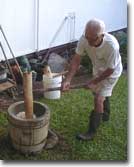 My family still pounds mochi (rice cakes) every New Years, a Japanese custom that has survived with help from Grandma and Grandpa amidst a world that’s evolving, sometimes too quickly, into a high-tech society. It’s a tradition that we’re proud of, and I would like to share our mochitsuki with you.
My family still pounds mochi (rice cakes) every New Years, a Japanese custom that has survived with help from Grandma and Grandpa amidst a world that’s evolving, sometimes too quickly, into a high-tech society. It’s a tradition that we’re proud of, and I would like to share our mochitsuki with you.
We gather at my grandparents’ house in Papaikou, on the Big Island, the Sunday between Christmas and New Years. This year it was on December 26. Under clear skies, we huddled near the fire, warming up in the cold country morning. It would be our last mochitsuki of the millennium!
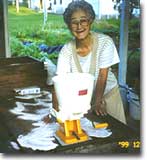 Here are the steps my family uses to make our mochi every year:
Here are the steps my family uses to make our mochi every year:
1. Make an (azuki, or red bean) balls the day before.
2. Wash the rice. We used 60 pounds this year
3. Prepare the table with katakuriko (potato starch).
 4. Steam the rice over the fire in seiro (containers for steaming).
4. Steam the rice over the fire in seiro (containers for steaming).
5. Put the cooked rice through the machine once. (Well, the “machine” is powered by Grandpa’s old, makeshift washing machine motor! But it cuts our pounding time by half.)
6. Pound the mochi in the usu (cement mortar), with the kine (wooden mallet). Usually two people will start, while Uncle Arnold turns the mochi and picks out the wooden splinters. Then, as the mochi gets soft, just one person takes over. Grandpa always pounds the first and last batch. The last two batches are made with yomogi, which turns the mochi green.
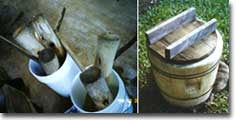 7. Cut the mochi. When my great-grandmother was alive, she would cut the mochi with her hands. Without her worn-from-working-hard-in-the-canefield hands, the mochi is too hot for anyone else. We now use a machine to cut the mochi.
7. Cut the mochi. When my great-grandmother was alive, she would cut the mochi with her hands. Without her worn-from-working-hard-in-the-canefield hands, the mochi is too hot for anyone else. We now use a machine to cut the mochi.8. Make the mochi. The women gather at the table full of potato starch and make mochi according to what Grandma says: hira mochi, osonae mochi, “an” mochi…
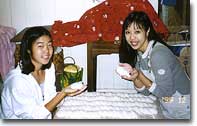 9. Take the mochi in to the house to cool.
9. Take the mochi in to the house to cool.
10. Stack the mochi as it cools, and pack it in boxes leftover from Christmas presents.
11. Clean the table with butter knives to take off all the sticky mochi.
Grandpa and Grandma start long before the sun rises. This year I got up at 5:00 AM to pick up my cousin and her boyfriend from the airport. By the time we reached Papaikou at 6:20, the fire was already started and Grandma had breakfast ready for all of us!
 We started the first usu at 7:15, as aunties, uncles, cousins and friends trickled in. Mochitsuki is usually the only time I have to see some of my cousins! It’s wonderful to see the family grow, and talk story with the people who have inevitably influenced me to become the person I am today.
We started the first usu at 7:15, as aunties, uncles, cousins and friends trickled in. Mochitsuki is usually the only time I have to see some of my cousins! It’s wonderful to see the family grow, and talk story with the people who have inevitably influenced me to become the person I am today.
By 11:30 we were done! After cleaning up and eating lunch, our Mochitsuki Day was finished by 1:00.
For only a half day’s work, it’s well worth waking up at 5:00 in the morning on my day off. I’m determined to uphold the values and traditions that I’ve learned from my grandparents, and resist the temptation to forget the “old ways.” I realize that I have something that ‘s become rare in today’s rush-rush society, and appreciate special efforts my family takes to perpetuate traditional customs.
And, after working so hard, it just makes the ozoni taste better!
|
Susan Sensei’s English Lesson #11(スーザン先生の英語講座 その11) For two years I taught English in Japan, and was “スーザン先生” to my students in Ikaho town, Gunma Prefecture. I will try and introduce new words and phrases for the Japanese visitor to Hawaii. Here is this week’s situation: 【今週のレッスン】 ◆「明日6時にモーニングコールをしてもらえますか?」英語で言ってみましょう! ◆”May I have a 6:00 wake up call tomorrow morning?”Have a nice trip! |
| Loco Girl’s Profile(ロコ・ガールのプロフィール)
Born in Hilo, I grew up going fishing with Dad, shopping with Mom, and trying to be a good “big sister” to a younger sister and brother. A Waiakea High School and the University of Hawaii at Manoa alumni, I taught English in Japan for two years on the JET Program, and am now employed at PacRim Marketing Group, Inc. I love doing a lot of things-shopping, reading, lettering, making jewelry & crafts, watching Friends-and that’s just the start of my list! I like being busy, and am active with the JET Alumni Association (JETAA) and the Honolulu Junior Japanese Chamber of Commerce (HJJCC.) My family and friends are, of course, very important to me, and are why I live a very typical, happy, local-style life in Hawaii and will never leave! |


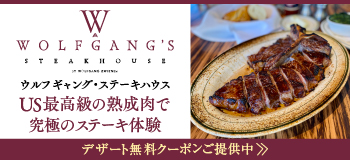



コメントを残す